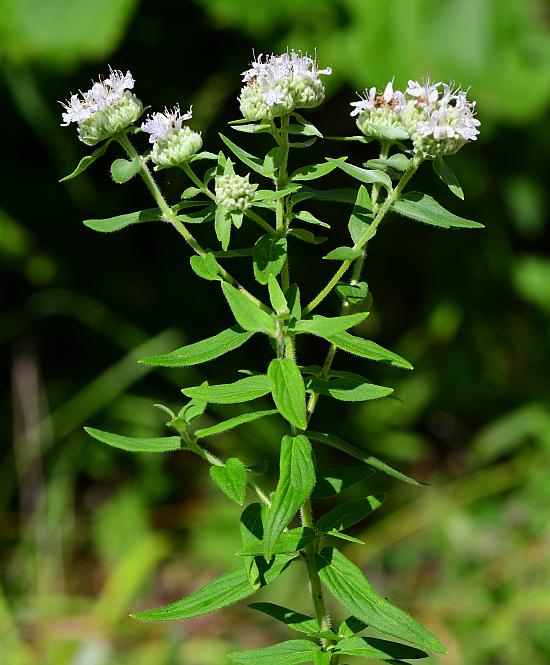Pycnanthemum pilosum Nutt.
Hairy Mountain Mint

Native
CC = 5
CW = 3
MOC = 73
© SRTurner
Pycnanthemum pilosum Nutt.Hairy Mountain Mint | |
 |
Native CC = 5 CW = 3 MOC = 73 |
© SRTurner |
|
Family - Lamiaceae Habit - Perennial forb with fibrous roots and short, woody rhizomes. Bruised herbage fragrant with menthol aroma. Stems - Ascending to erect, to 1.5 m, stout, 4-angled, single to multiple from the base, branching mostly in the inflorescence, moderately to densely pubescent on the angles and sides with mostly short, spreading hairs.
Leaves - Opposite, simple, sessile to very short-petiolate, the largest leaves with the petioles 1-3 mm long. Leaf blades 2-8 cm long, 4-20 mm wide (those of the largest leaves 8-20 mm), lanceolate, elliptic-lanceolate, elliptic, or oblong-elliptic, mostly narrowly angled or tapered at the base, the margins usually entire, less commonly with a few shallow teeth, the upper surface glabrous or sparsely short-hairy, green, the undersurface grayish green, moderately to densely pubescent with relatively long, spreading hairs and numerous sessile glands.
Inflorescence - Dense, terminal corymbiform cyme of many headlike flower clusters. Each cluster subtended by an involucre of small leaflike bracts, these grayish green, densely pubescent with short, curled hairs on the upper surface, moderately to densely pubescent with relatively long, spreading hairs on the undersurface. Bractlets 3-5 mm long, linear to narrowly lanceolate.
Flowers - Calyces 3.5-4.5 mm long, actinomorphic or nearly so, densely pubescent with relatively long, woolly hairs, lacking longer bristly hairs on the margins or tip, the lobes all similar in size and shape, 0.5-1.0 mm long, triangular, sharply pointed and usually with a minute, bristly extension of the midnerve. Corollas zygomorphic, bilabiate, 5-8 mm long, white to pale lavender, with purple spots internally. Corolla tube 4 mm long, glabrous basally, villous apically, villous internally, 4-lobed. Upper lip single-lobed. Lobe 3 mm long, 1.5 mm broad, glabrous internally. Lower lip 3-lobed. Central lobe longer than the lateral lobes, to 4 mm long, 1.4 mm broad, rounded at the apex, with a slightly wavy apical margin. Lateral lobes 2 mm long, 1.5 mm broad. Lower lip bearded internally. Style 1, exserted from between the ovaries and from under the upper lip, glabrous, white, 9 mm long. Stigmas unequal. Ovary green, 4-parted to about 1/3 or 1/2 its length, 1 mm long in flower, glabrous basally, with long erect white hairs apically. Each division of the ovary about 0.2 mm long. Stamens 4, didynamous, adnate at the apex of the corolla tube, partially exserted. Filaments white, glabrous, to 2 mm long. Anthers yellow to pink when fresh, quickly drying to brownish-red, 0.3 mm long.
Fruits - Nutlets 1.0-1.3 mm long, sparsely hairy toward the tip. Flowering - July - September. Habitat - Upland forests and prairies, savannas, glades, ledges and tops of bluffs, streambanks, pond margins, fields, cemeteries, railroads, roadsides, open disturbed areas. Origin - Native to the U.S. Lookalikes - P. tenuifolium, P. virginianum, other members of the genus. Other info. - This attractive species can be found throughout most of Missouri, somewhat less abundantly in the northwestern quadrant of the state. Missouri and Illinois comprise the major part of the plant's natural range, with more scattered populations in adjacent states. The plant is fairly easy to identify from its lanceolate, opposite leaves, densely furry 4-angled stems, and dense terminal clusters of flowers. Relative to P. tenuifolium, P. pilosum has much wider leaves, a greater degree of hairiness overall, and a much stronger minty fragrance. Relative to P. virginianum, P. pilosum has stems which are hairy both on the surfaces and the angles, rather than only on the angles. Photographs taken near Big Spring Park, MO., 7-8-04 (DETenaglia); also at Klondike County Park, St. Charles County, MO, 8-4-2014, and Shaw Nature Reserve, Franklin County, MO, 8-12-2020 and 8-4-2021 (SRTurner). |